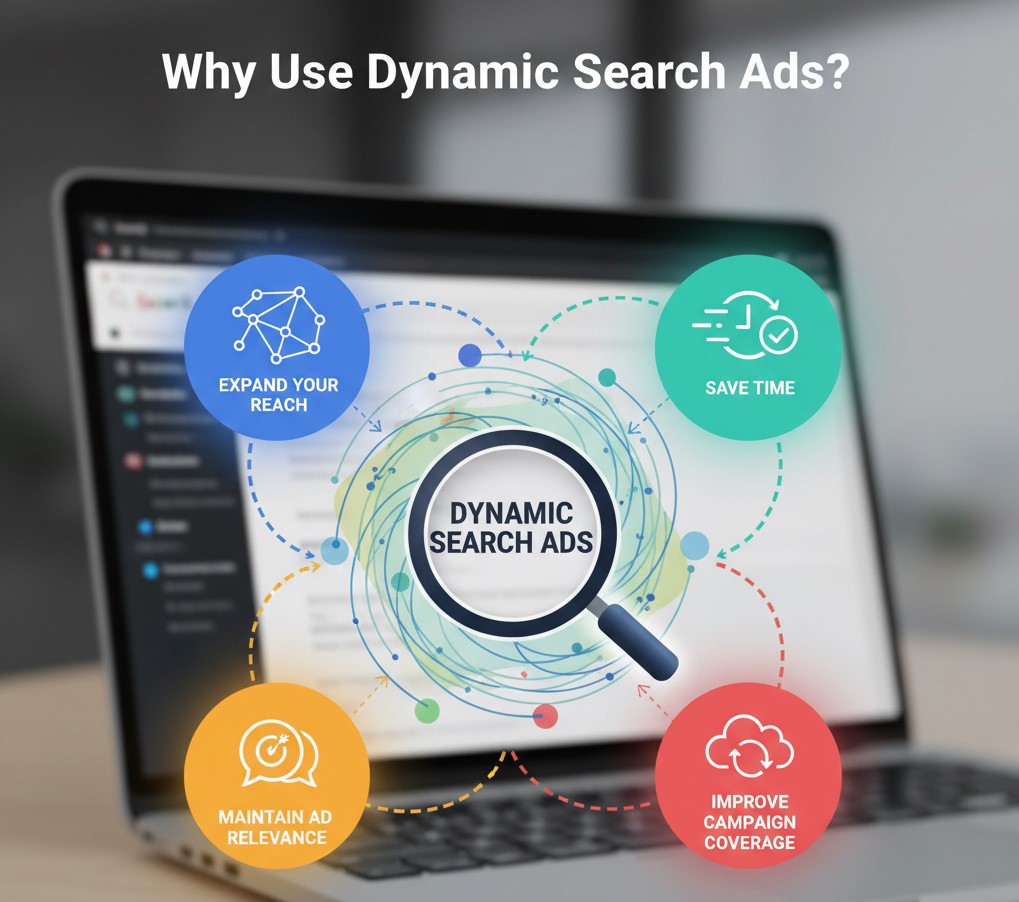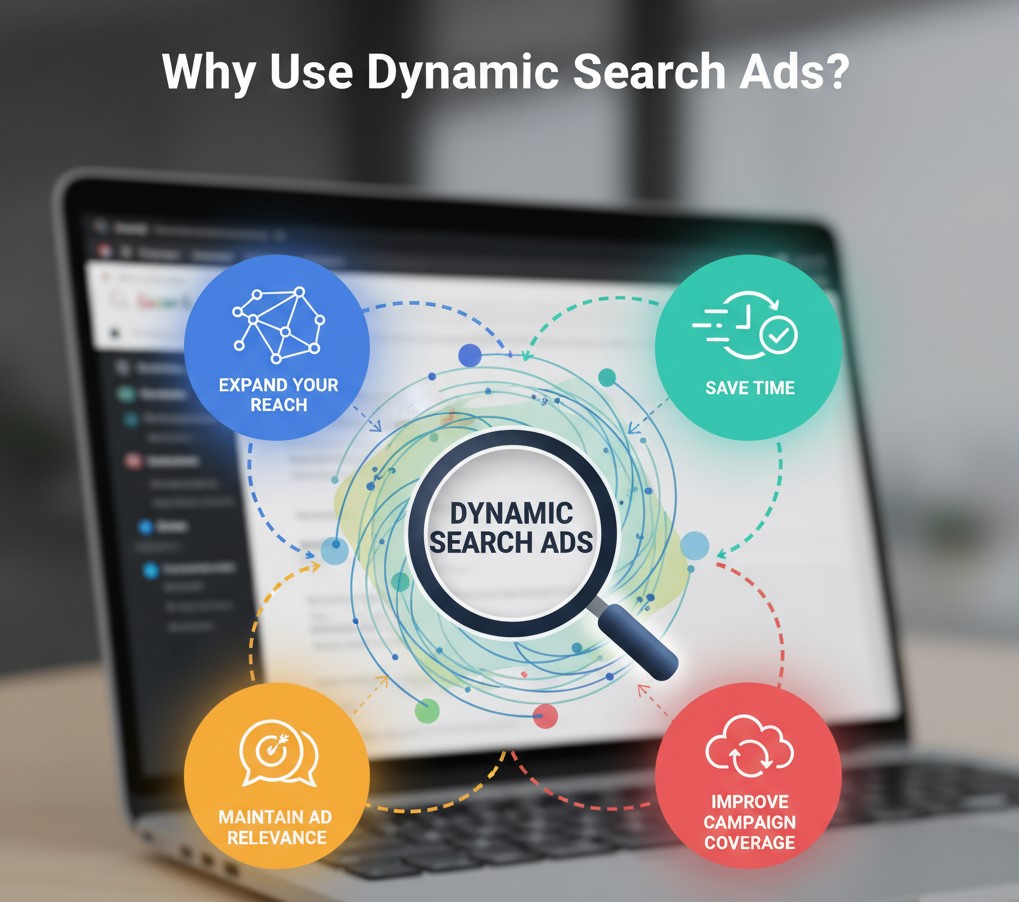
Search Engine Marketing (SEM) is evolving, and one feature that has gained increasing importance is Dynamic Search Ads (DSAs). If you’re asking, “What are dynamic search ads in SEM?”, you’re not alone. This advertising method often confuses marketers new to SEM or those transitioning from static keyword-based campaigns.
In this post, you’ll get a clear, human-readable explanation of DSAs. You’ll learn how they work, when to use them, and why many businesses rely on them to increase their visibility and efficiency in paid search advertising.
Understanding the Basics of Dynamic Search Ads
Dynamic Search Ads are a type of Google Ads campaign where Google automatically generates ad headlines and landing pages based on your website’s content. Instead of targeting keywords manually, Google scans your site and matches search queries to the most relevant pages.
Here’s the key: DSAs use your website content—not keywords—to decide when and where to show your ads.
This makes them different from standard text ads, where advertisers have to manually choose the keywords and write the ad copy for each ad group.
How DSAs Work Behind the Scenes
When a user searches for something on Google, the system checks whether your site has a page that matches the intent of that search. If it finds a match, it dynamically generates:
- A headline closely related to the user’s search
- A final URL leading to the relevant page
- A display URL based on your domain
Only the description lines of the ad are written by you. Everything else is handled by Google in real-time. This allows your ad to stay relevant without constant manual updates.
Why Use Dynamic Search Ads?

Dynamic Search Ads are powerful tools for several reasons, but they’re not magic. They work best for websites with a lot of well-structured content and clear product or service pages. If your site fits that description, DSAs can:
Expand Your Reach
You can capture more search queries than with traditional keyword targeting. DSAs help fill in gaps where you might have missed relevant keywords.
Save Time
You don’t have to write dozens of headlines or maintain long keyword lists. Google automates most of the process.
Maintain Ad Relevance
Since Google dynamically generates headlines that match what people search for, DSAs tend to deliver better click-through rates than generic ads.
Improve Campaign Coverage
If you launch a new product or update your content, DSAs can begin targeting those pages instantly. No need to add new keywords or ads manually.
When Should You Use DSAs?
Dynamic Search Ads are ideal for businesses with:
- A large inventory of products or services
- Regular content updates
- Structured websites with clear headings and content
- The need to save time on keyword management
They’re not a great fit for small sites, sites with minimal text content, or businesses in highly regulated industries where ad messaging must be tightly controlled.
Real-World Application Example
Suppose you run a website selling running shoes. Your traditional campaign may include keywords like “men’s running shoes” or “best running shoes for women.” However, someone might search for “waterproof trail running shoes size 9.”
If you haven’t added that keyword manually, a regular ad might not show.
But with DSAs, Google can recognize that you have a page about trail running shoes. It will then automatically create a headline and link to that product page, increasing your ad’s visibility and relevance.
Best Practices for Running DSAs

While Google handles a lot of the automation, there are a few best practices you should follow to get the best results:
Keep Your Website Structured
Your site’s layout and content guide the entire DSA process. Make sure product pages are clearly organized with meaningful headlines and descriptions.
Use Negative Keywords
To avoid wasting budget, add negative keywords to prevent your ads from showing for irrelevant queries. This gives you more control over the traffic.
Write Strong Descriptions
Since you can’t control the headline, your description lines need to do the heavy lifting. Focus on benefits, promotions, or strong calls-to-action.
Monitor Performance Regularly
Even though DSAs are automated, they still need monitoring. Watch for pages or search queries that don’t convert well and make adjustments as needed.
Use Page Feeds for Control
Google allows you to upload a page feed—a list of URLs that you want Google to consider for DSA targeting. This gives you a way to steer the automation process while still leveraging its benefits.
Are DSAs Good for All Businesses?
No, and that’s important to understand.
If your site lacks detailed content, Google might struggle to generate meaningful ads. Also, industries with legal restrictions on ad copy should be cautious—because you can’t fully control the headlines.
For e-commerce businesses with hundreds of products, however, DSAs are a goldmine. They help scale ad campaigns with far less effort than manually creating ads for each product.
Combining DSAs with Keyword Campaigns
DSAs don’t have to replace your keyword campaigns. In fact, many advertisers run them side-by-side. Keyword campaigns give you full control over targeting, while DSAs fill in the gaps.
If used correctly, DSAs can act as a discovery tool. You can identify new search terms that convert well and later add them to your manual keyword campaigns for full control.
Reporting and Optimization
In your Google Ads dashboard, you can review:
- Search terms triggering your DSAs
- Performance by landing page
- Conversion data
This data helps you fine-tune your page feeds, negative keywords, and even your on-site content.
By continuously analyzing this information, you can turn a “set-it-and-forget-it” tool into a strategic performance booster.
Final Thoughts
So, what are dynamic search ads in SEM? They are a semi-automated advertising method where Google dynamically generates headlines and destination URLs based on your website’s content. They help advertisers save time, expand reach, and improve relevance in paid search campaigns.
However, DSAs are not perfect for every business. They require a clean website structure, active monitoring, and careful use of exclusions.
For marketers managing large websites or e-commerce platforms, DSAs offer a practical and scalable solution to improve visibility without the manual effort of managing every keyword and ad copy variation.
As automation and machine learning continue to shape the future of SEM, tools like Dynamic Search Ads are becoming essential components in a modern marketer’s toolkit. By blending automation with strategy, DSAs can unlock growth, drive performance, and maximize the ROI of your digital ad spend.
Learn more about: Social Media Advertising: Your Complete Guide to Success


Leave a Reply